Brief
With so many businesses looking for ways to reduce their energy consumption—because of cost, environmental concerns or the need to comply with regulations— the opportunities to build businesses that deliver on those needs are large and growing. Analysts expect double-digit growth in this energy-efficiency market over the next few years, with more than 70% from commercial and industrial customers, and the rest from residential (see Figure 1). That will include about $400 billion in energy-efficient hardware and machines and $200 billion in consulting, data management and other energy services.
Many companies are already trying to become more energy efficient, and there is no shortage of companies with ambitions to build their own businesses to help them (see the Bain Brief "Hidden treasure: Why energy efficiency deserves a second look"). Equipment manufacturers Alstom, ABB, Schneider and Johnson Controls sell energy-saving equipment and process-optimization services linked to their products. IT companies like Cisco, IBM, Microsoft and SAP have programs to collect and manage energy data. Energy-contracting and civil works companies such as Spie and Vinci Energy Services provide installation support and are moving to maintenance and services. Energy service companies (ESCOs) like Dalkia, Cofely, Wood Group and Getec offer a range of integrated energy services, including consulting and metering. And energy suppliers such as E.ON and RWE are establishing energy service groups to enter this market.
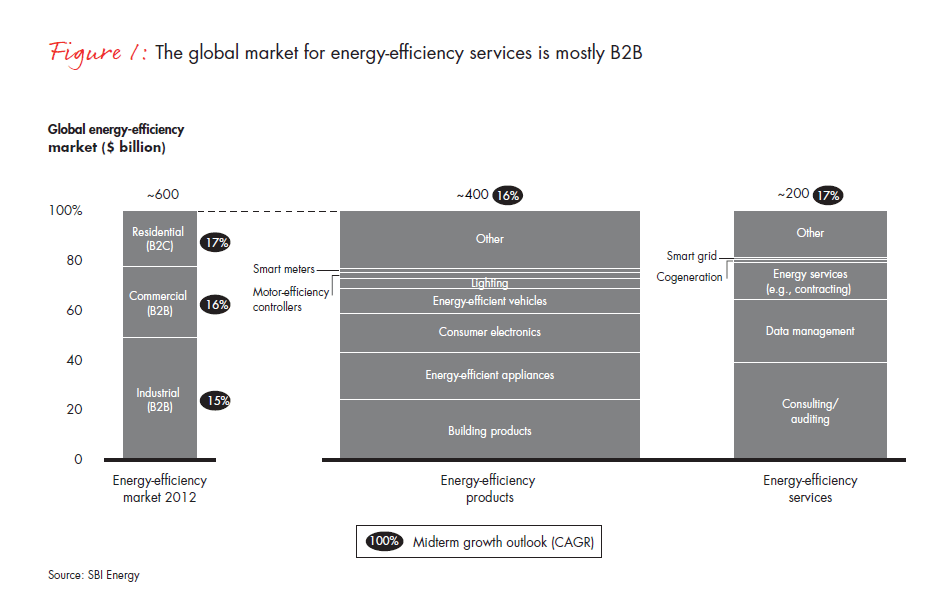
At Bain, we believe that energy-efficiency services represent a compelling new service line for all of these and other industrial companies, and we see a wide range of opportunities along the value chain (see Figure 2). Businesses and households want to lower their energy bills, hedge against volatility, or adopt measures that help protect the environment and allow businesses to meet their corporate responsibility goals. Regulations also provide a strong incentive for companies to invest in efficiency. With the EU falling short on its energy-efficiency goals, governments are taking various measures, including subsidies and tax incentives for making buildings more efficient (see below "Across regions, regulation encourages energy efficiency").
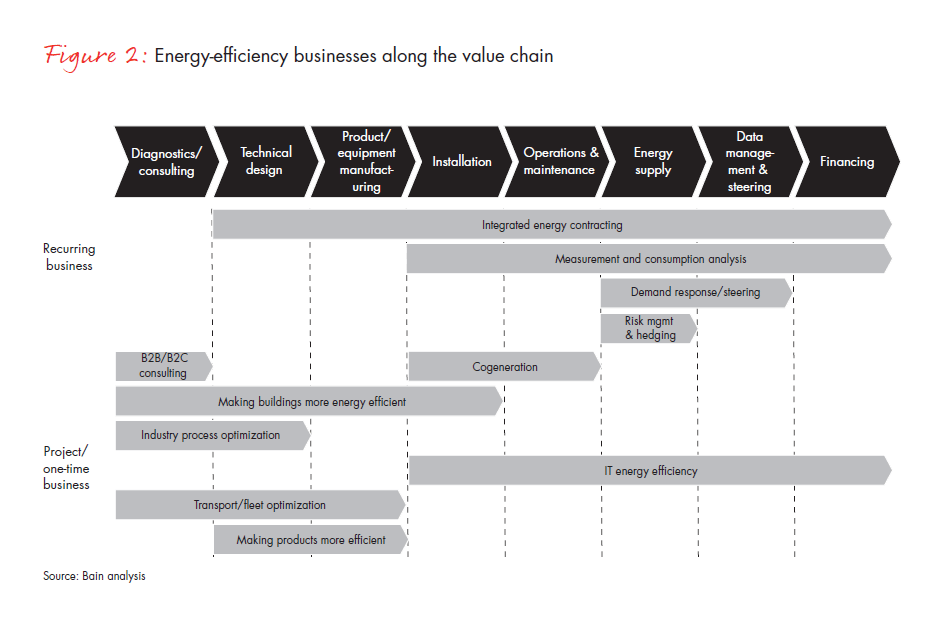
Utilities and other ESCOs are among the core group of players looking closely at this opportunity, since it is adjacent to some of the services they already provide (see Figure 3). Some utility executives, however, tell us that they struggle to quantify the business opportunity—and three out of four we talked with in a recent series of conversations saw it as more of a risk than an opportunity. Only one in five said their organizations were well prepared to take advantage of this promising new business line.
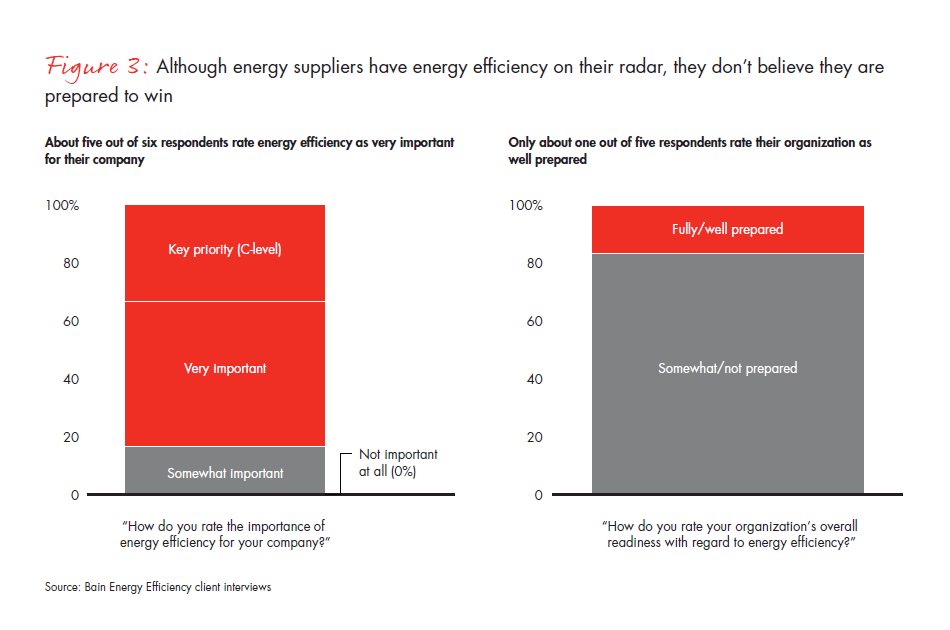
ESCOs, perhaps not surprisingly, are more likely to see the upside. Executives in that part of the industry see energy costs rising and are eager to tap into the global $600 billion market for energy-efficiency services and hardware.
Opportunities for different types of players
Three main groups of companies competing for energy-efficiency business approach the market from different perspectives and have unique strengths (see Figure 4). ESCOs have built their businesses around client relationships and a keen understanding of customer needs. Product manufacturers focus on equipment, appliances and processes; much of their work is a one-time effort, selling and installing equipment. The third group, utilities, has a history of building and maintaining large infrastructure to generate and distribute power. Their experience supplying energy and matching with demand should serve them well in the efficiency business. These groups also look to form partnerships to tap the best skills each has to offer.
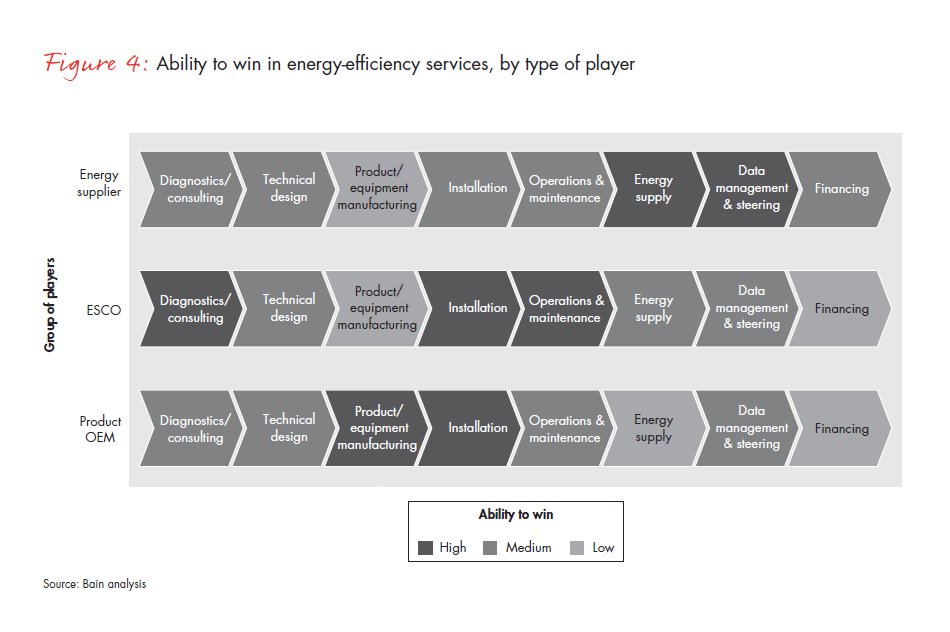
ESCOs are among those best positioned to lead the energy-efficiency services market. Based on their strong relationships to a dispersed base of small to midsize clients and their service culture, they can win in diagnostics, consulting and installation, as well as in operations and maintenance. Some provide metering, data-processing and demand-management services, and we see a great deal of potential for them to thrive under their own brand or as a source for others’ services. Some started from energy installation or public works and are now moving to maintenance and services. Many are already selling energy-efficiency services, which they see as a key priority. But their small scale and lack of access to capital may inhibit their potential for growth. In the past, they often turned to third parties when the engineering demands became too complex. Now many are realizing that this could be a source of differentiation, so they are developing internal expertise in engineering and design. Some players, like Cofely, a division of GDF Suez, are moving into contracting and engineering, as well as into facility management. Others, like Dalkia, will rely on their experience in international markets and local experience as a source of differentiation, and will seek to industrialize their operations.
Product manufacturers will see opportunities as customers replace and upgrade their older, less-efficient equipment and appliances. In most cases, they are focused on proprietary products and are less concerned with services around third-party products and equipment. They may find it challenging to offer ongoing energy services to their fragmented customer bases, partly because most lack the customer service skills to maintain those relationships— especially if a third-party retailer or contractor sits between them and their customers. However, some (Schindler, ABB) are investing in data management and steering capabilities, and we expect them to take share in that area because they are willing and able to invest.
Utilities, particularly large utilities, are right to see the downside in a trend toward energy services. They have traditionally followed an asset-centric business model for generating and distributing power. Now, depending on the country, up to 40% of the profits from power generation and retail gas delivery are at risk across Europe, driven by the rise of distributed generation and reduced demand for energy (see the Bain Brief "Distributed energy: Disrupting the utility business model"). New opportunities like smart-home services or distributed energy management will probably not compensate for these losses. Despite their place at the center of the energy value chain, most large utilities are not well positioned to enter the energy-efficiency business. Their operating model is based on centralized assets, which doesn’t align well with the local nature of a service offering. Their costs are too high to offer competitively priced contracting services managing a large number of local installations. However, they do have experience managing complex energy systems, which gives them an edge in data management and steering. In addition, their large customer base may give them a scale advantage in sourcing and field service, like that of Centrica in the UK. They may want to partner with smaller firms that have closer ties with local businesses and are better positioned to excel in installation, operations and maintenance.
Regional and municipal utilities have better customer loyalty ratings than larger utilities, which could help them build energy-efficiency businesses (see the Bain Brief "Turning on utility customer loyalty"). They also have access to distributed heat systems, which are a prime focus of efficiency programs. Smaller utilities often have difficulty financing or making the case for new business lines, but we see a real opportunity for them to bring their deep customer insights and relationships into partnerships with local contractors and installers. They often have close ties to other municipal organizations (for example, municipal housing or public transport companies) that can help them build local business and references. Several regional utilities in Germany told us they are reaching out to the business customers of their “sister companies” as they build their energy-efficiency service lines.
Six rules for building a successful energy-efficiency business
Our work with companies offering energy-efficiency services, our analysis of success factors and our discussions with executives active in the market have helped us distill six principles for a successful energy-efficiency business.
1. The B2B business opportunity is more significant than B2C. As noted, we expect businesses to account for more than 70% of the energy-efficiency market opportunity. Businesses respond more actively to savings opportunities and their average investment and account value is significantly higher than that of households. To tap this market, energy-efficiency service providers will need to define a clear value proposition for businesses, often tailoring the solutions to the industry. That can help potential buyers quantify the long-term benefits in terms of total cost of ownership. It may require deep technical expertise of the industry and deploying the right talent. For example, the needs of a hotel chain (heat for rooms, water and cooking; lighting; repetition and scale across several facilities) would differ from those required for a manufacturing plant (industrial and facility steam and heating, energy for machinery). Providers will also need to identify their most likely business customers and target the right buyers within those markets. Winning requires customer insights at the local level, paired with a regional scale of operations and expertise.
2. Build energy-efficient services on growth waves. Over time, demand for services grows steadily, but opportunities come in waves based on external events and trends, such as new regulations and technologies. For example, the rise of distributed generation creates new demand for efficiency as customers take greater responsibility for their own energy use. The trend toward smart homes increases residential customers’ interest in reducing their energy consumption. Regulatory waves such as the European Energy Efficiency Directive (see the sidebar "Across regions, regulation encourages energy efficiency") increase the focus on energy efficiency, as commercial and residential customers adopt measures to meet new guidelines. Low interest rates may spur businesses and households to upgrade, replacing lights, windows, roofs and other infrastructure. A leading energy measurement services company, Ista, expects significant business growth over the next five years, largely on services resulting from new regulations in Europe and emerging markets. With this in mind, successful energy-efficiency businesses must have market insight into events that could create new demand. They should be attuned to the requirements of new regulations, and ready to scale up when necessary in order to capture new business. Ideally, they can help shape the details of new regulations. Finally, they should be able to commit on energy savings through performance-based contracts and remuneration.
3. Successful energy-efficiency service lines supplement existing business platforms. Successful energy-efficiency offerings capitalize on existing strengths, whether those include technical expertise, customer relationships or a place on the energy-delivery chain. For example, since end-to-end energy efficiency is increasingly a key purchasing criterion for vehicles and equipment, we see potential for companies that can help product manufacturers make their goods more efficient. Other opportunities lie in planning, construction or installation services that improve energy efficiency when customers renovate buildings. For utilities already delivering energy to customers, metering services, financing, auditing, contracting or operating customer assets can all offer incremental, recurring sources of revenue.
As companies begin to offer energy services that build on their strengths, they must create the right bundles and train their salespeople and field forces to ensure they can deliver against any ongoing service needs.
4. Business models need to work with long-term economics. The greatest opportunities in energy efficiency (for example, switching to LED lighting) can generate significant savings, up to 50% annually. But the payback can take years, sometimes up to 25 years for building enhancements (see Figure 5). This is a long time for many clients, who tend to plan in three- to five-year horizons. Some quick wins, such as metering, pay back in less time, but the potential upside is smaller.
Businesses often invest in efficiency because of regulations. But regulatory positions can change with political winds, while infrastructure investments are made to last for many years. Customers may be reluctant to invest in efficiency if they think the rules will change again. Some smaller companies may also need to raise financing for larger investments in efficiency. Given both of these hurdles, a contract model seems promising for providers, since it creates opportunities to work with customers who may not be able to finance large, one-off investments.
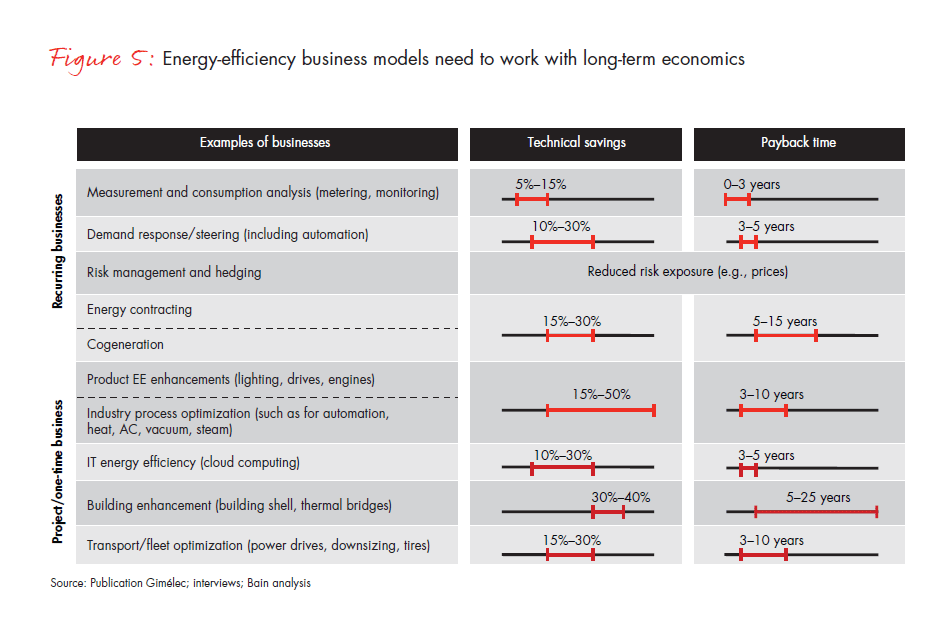
5. The opportunity is about heat and electricity. Across sectors, we see great opportunities working with facility owners to improve the insulation capabilities of buildings, upgrade heating and cooling networks, and enhance metering and automation to make better use of heat systems (see Figure 6). To make the most of these opportunities, providers will need to offer a broad range of technological options in order to provide the best solutions.
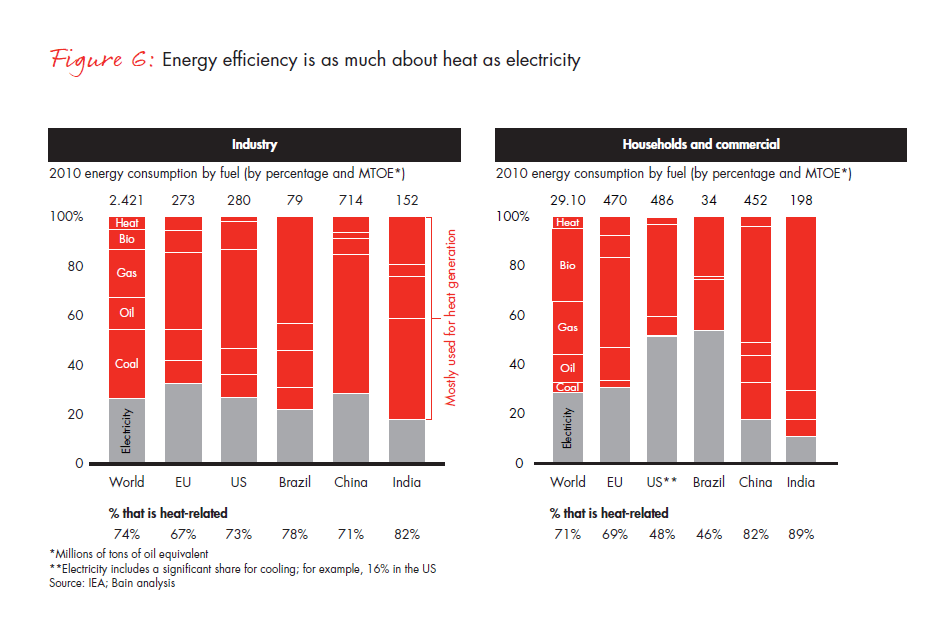
6. Local market share matters. Energy-efficiency services, like most service businesses, require knowledge of local regulations and contacts. Leaders start out by building share in a few local markets, and then expand—but they should be careful not to spread their field service too thinly across a broad area, which could hurt their ability to deliver flawless and timely service. Although the focus is local, companies can still expect some cost and marketing benefits to extend across multiple locations.
Developing a business model for energy-efficiency services
As with any new business, shaping the plan to deliver a new line of services involves many strategic and tactical decisions. Four questions are especially important.
- What is your differentiating value proposition? What unique benefits does your service bring to the target customers? How does this translate into a profitable revenue model to see you through the initial investment and financing cycle?
- What operating model will develop traction? Decide which part of your business has the best platform to develop an energy-efficiency-service business. In some cases, it may make sense to set up a separate company that can focus on developing the right skills and sales approach—although it will also want to stay in touch with the parent company’s capabilities and customers.
- What partnerships or acquisitions do you need? Given the complementary skills of players at different points in the value chain, what types of companies (and which companies in particular) would make the best partners?
- How do you track and influence the stakeholder ecosystem, including investment partners and customers? What role do local communities play in the energy markets and regulations? Given the importance of regulation in determining investments in efficiency, what new rules are likely to drive new waves of investment?
Asking these questions can help executives frame their opportunities in this rapidly growing field and gain a clearer picture of the challenges they face in building a successful energy-efficiency business.
Across regions, regulation encourages energy efficiency
Governments around the world are creating a regulatory environment supportive of energy-efficiency services, including incentives for making buildings more energy efficient, establishing transparency on consumption through more accurate measurement and managing energy demand more intelligently.
The European Energy Efficiency Directive (EED) aims to reduce energy consumption by 20% by 2020, creating 400,000 jobs along the way. Investments in energy efficiency of around €24 billion could reduce energy costs by €6 billion annually. Key elements of the EED focus on improved metering and more transparency in billing. New and existing buildings will have to install submeters to measure more accurately their use of heat, gas and electricity. Programs to improve the efficiency of new buildings, such as the UK’s ECO (Energy Companies Obligation) program, are also going into effect.
In the US, states have led on energy-efficiency efforts. California’s Energy Efficiency Resource Standards call for about 16 terawatt hours of electricity savings between 2012 and 2020, amounting to 0.85% annual savings through 2020. For example, energy-efficient building standards have helped reduce consumption by requiring better windows and improved insulation. Massachusetts, New Y ork and Oregon are among the other states with progressive energy-efficiency guidelines. At the federal level, there is no comprehensive set of rules equivalent to the EED, but some federal programs target certain aspects. The EPA’s Star label, for example, tells buyers which appliances use less energy than required by federal standards.
The ACEEE 2012 International Energy Efficiency Scorecard rates Japan as the most efficient industrialized economy in Asia. India has launched several initiatives aimed at improving energy efficiency, to address climate change and other domestic priorities. India’ s PAT (perform, achieve, trade) scheme should help create new opportunities for utilities in operations and maintenance as well as in energy efficiency.
Arnaud Leroi is a partner in Bain & Company’s Paris office. Kim Petrick is a partner in Bain’s Munich office. Bruce Stephenson is a Bain partner in the Chicago office. All three work with Bain’s Global Utilities practice.





